Wildflowers, Grasses and Other Nonwoody Plants
Media
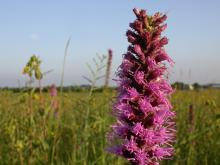
Species Types
Scientific Name
Liatris spp.
Description
Missouri boasts nine native species of blazing stars, or gayfeathers, in genus Liatris. These showy, upright, unbranching spikes of magenta-pink wildflowers bloom in sunny habitats.
Media
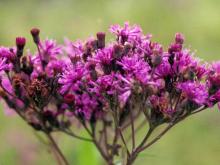
Species Types
Scientific Name
Vernonia spp.
Description
Five species of ironweeds live in Missouri. Starting in the middle of summer, they bear showy clusters of magenta or purple flowerheads at the branching tops of upright stalks.
Media
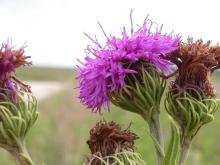
Species Types
Scientific Name
Vernonia arkansana
Description
Curlytop ironweed is one of Missouri’s five species of ironweeds. It’s easy to identify because of its tapering, curling, threadlike involucral bracts. Also, it is usually a smooth, hairless plant.
Media

Species Types
Scientific Name
Eupatorium serotinum
Description
Late boneset, or late-flowering thoroughwort, is a native perennial wildflower with clusters of white, fuzzy-looking flowers. It’s one of nine similar-looking species of thoroughworts in Missouri.
Media

Species Types
Scientific Name
Eupatorium spp.
Description
Nine white-flowering species of thoroughworts, or bonesets, have been recorded for Missouri. They have rounded flower clusters that look rather fuzzy, because each little composite flowerhead lacks petal-like ray florets.
Media
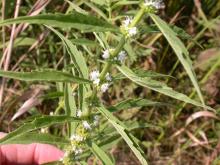
Species Types
Scientific Name
Lycopus americanus
Description
Not the showiest of wildflowers, American bugleweed will catch your eye with its interesting geometry. The narrow, toothed leaves are opposite on the stalks and occur at right angles to the pair below.
Media
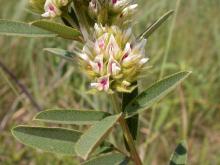
Species Types
Scientific Name
Lespedeza capitata
Description
Round-headed bush clover is a stiffly upright plant that has rounded flower clusters with cream-colored, pea-shaped flowers with purple markings on the banner petal. It grows statewide in open habitats.
Media
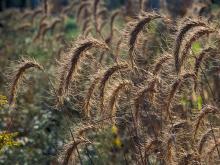
Species Types
Scientific Name
Elymus canadensis
Description
Canada wild rye can be identified by its bristly seed heads, which curve downward. As the seeds mature, the straight, long awns curve and bend. This is a common native cool-season grass that reaches about 4 feet tall and is highly valued as forage and hay for livestock.
Media
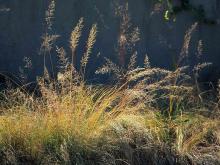
Species Types
Scientific Name
Sporobolus heterolepis
Description
Prairie dropseed is a native perennial bunch grass that forms dense clumps of fine, light green, arching leaves. The seed heads are airy, open, branching clusters bearing small, ovate florets on their own individual branchlets.
Media

Species Types
Scientific Name
Hexalectris spicata (syn. Bletia spicata)
Description
Crested coral root is an orchid that lacks chlorophyll, so none of it is green. It obtains nutrients from fungi and decaying organic matter. Compared to our other coral roots, it is taller and has larger flowers. It grows in Ozark habitats.
See Also
About Wildflowers, Grasses and Other Nonwoody Plants in Missouri
A very simple way of thinking about the green world is to divide the vascular plants into two groups: woody and nonwoody (or herbaceous). But this is an artificial division; many plant families include some species that are woody and some that are not. The diversity of nonwoody vascular plants is staggering! Think of all the ferns, grasses, sedges, lilies, peas, sunflowers, nightshades, milkweeds, mustards, mints, and mallows — weeds and wildflowers — and many more!





















